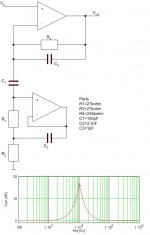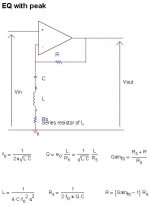Tylantyr, thanks, very constructive comment.
I believe what Jens does is just great and I appreciate his help and his boards once they are available. So keep the good work up, Jens!
I would appreciate if we can have only one board version which could use both discrete and ordinary opamaps like you oulibed it before as I like to test the difference by plug and play with them.

I believe what Jens does is just great and I appreciate his help and his boards once they are available. So keep the good work up, Jens!
I would appreciate if we can have only one board version which could use both discrete and ordinary opamaps like you oulibed it before as I like to test the difference by plug and play with them.
Blitz said:
I would appreciate if we can have only one board version which could use both discrete and ordinary opamaps like you oulibed it before as I like to test the difference by plug and play with them.
I agree, even if I'll probably go with discrete opamps nothing prevents us from making the boards in order to accept both.
Cheers
Andrea
Jens do you think I could use the opamp posted in the MOX crossover for your equalisation circuits.
I might make my own PCB board and I wanted to know if it will work.
I might make my own PCB board and I wanted to know if it will work.
moamps opamp
Hi,
I can't really say, if the opamp performs like a normal opamp you can. However since the open loop gain is smaller, acording to moamps, I'm not sure what will happen in an EQ circuit. - try it and tell us about it 🙂
I don't know about about the specs of moamps descrete opamp, perhaps a thread about descrete opamps is an idea?
moamps can you post specs on the opamp for us?
\Jens
Hi,
I can't really say, if the opamp performs like a normal opamp you can. However since the open loop gain is smaller, acording to moamps, I'm not sure what will happen in an EQ circuit. - try it and tell us about it 🙂
I don't know about about the specs of moamps descrete opamp, perhaps a thread about descrete opamps is an idea?
moamps can you post specs on the opamp for us?
\Jens
Re: moamps opamp
Hi,
Measured values are:
open loop gain is ca 45dB, f(-3dB) is ca 30kHz
for gain=0dB, f(-3dB) is around 300kHz.
Please, give me particular values for one example of notch or peak and expected frequency response, I will make experiment and measurements with two spare discrete opamp and place here results.
regards
JensRasmussen said:moamps can you post specs on the opamp for us?
Hi,
Measured values are:
open loop gain is ca 45dB, f(-3dB) is ca 30kHz
for gain=0dB, f(-3dB) is around 300kHz.
Please, give me particular values for one example of notch or peak and expected frequency response, I will make experiment and measurements with two spare discrete opamp and place here results.
regards
Hi,
discrete OPAMP works with some limitations and changes:
- at 10kHz max. gain was ca 12dB,
- R3 and R4 (1M) on opamp must be omited,
- C3 was 4p7.
regards
discrete OPAMP works with some limitations and changes:
- at 10kHz max. gain was ca 12dB,
- R3 and R4 (1M) on opamp must be omited,
- C3 was 4p7.
regards
I was thinking what if we just use real coils to make the EQ filters.
I think that would work a lot better with the discrete opamps.
I think that would work a lot better with the discrete opamps.
Inductors and EQ
Hi,
Well you can use inductors, BUT in the case above you would need one wopping 2.4 [H] ! I think that is inpractical for most people?
L=C2*R2*R1
\Jens
Hi,
Well you can use inductors, BUT in the case above you would need one wopping 2.4 [H] ! I think that is inpractical for most people?
L=C2*R2*R1
\Jens
Re: Inductors and EQ
Hi,
but with a C=1nF, L will be .24H.😉
Nongyr eq can work very well. In this case we need only 2 or maybe 4 inductors, what can be interesting design.
Inductors are little bit expensive, but to me one old eq with inductors sounds better than those with gyrators.
regards
JensRasmussen said:Well you can use inductors, BUT in the case above you would need one wopping 2.4 [H] ! I think that is inpractical for most people?
Hi,
but with a C=1nF, L will be .24H.😉
Nongyr eq can work very well. In this case we need only 2 or maybe 4 inductors, what can be interesting design.
Inductors are little bit expensive, but to me one old eq with inductors sounds better than those with gyrators.
regards
I also like the idea of using inductors. It won´t be so much expensive without one opamp. Tha´s what I meant. You can change the other parts to suit the inductors. Also the indictors are not so big becaude here you don´t need any current demands.
Hi,
it is possible to wound any inductor for audio filter in ferrite body like on picture. (from conrad, one complete inductor will cost ca 10€). I think that we need only one or two eq in active filter with gentle correction (not higher than 6-12dB). Everything more means that speaker or something else is maybe faulty. To many eq's in filter will tend to destroy sound, IMHO. I will make some experiments with inductor based eq (with discrete opamp) for middle decade (from ca 500Hz to ca 5kHz) in next few weeks. Results will be published here.
Regards
PS
In 2/2004 hobby-hifi magazine (German) someone can find good article about active-passive crossovers and derivates.
it is possible to wound any inductor for audio filter in ferrite body like on picture. (from conrad, one complete inductor will cost ca 10€). I think that we need only one or two eq in active filter with gentle correction (not higher than 6-12dB). Everything more means that speaker or something else is maybe faulty. To many eq's in filter will tend to destroy sound, IMHO. I will make some experiments with inductor based eq (with discrete opamp) for middle decade (from ca 500Hz to ca 5kHz) in next few weeks. Results will be published here.
Regards
PS
In 2/2004 hobby-hifi magazine (German) someone can find good article about active-passive crossovers and derivates.
Attachments
In my case for instance the woofer needs a correction of 3-4 db attenuation at 1800 Hz from 800-3000 Hz. Thats not so high of a Q. If I am not mistaken Q = Fo/BW. If that is correct than the Q is 0,81.
I think that one EQ circuit per speaker is ok and only when needed.
I think that one EQ circuit per speaker is ok and only when needed.
Marchand is selling a passive LC LLXO.
dave
An externally hosted image should be here but it was not working when we last tested it.
dave
exactly like that. You can make the same things like in passive crossovers but with a lot smaller components. You can buffer everything and so the load remains always constant.
Can you use a tuned LRC parallel circuit with a buffer just like in the passive crossovers?
Can you use a tuned LRC parallel circuit with a buffer just like in the passive crossovers?
promitheus said:exactly like that. You can make the same things like in passive crossovers but with a lot smaller components
The values required for the chokes are quite large, and the trick to making these work is to get them right.
dave
To promitheus
Hi,
Just a note before you go and calculate alot on the EQ section for your filter.
You can NOT use the formulas for BP and BS filters for your EQ and get valid results.
An EQ section is NOT the same!
This means that the BW=fo/Q equation does not hold.
It's bettet to draw the grafs and see what you get.
\Jens
Hi,
Just a note before you go and calculate alot on the EQ section for your filter.
You can NOT use the formulas for BP and BS filters for your EQ and get valid results.
An EQ section is NOT the same!
This means that the BW=fo/Q equation does not hold.
It's bettet to draw the grafs and see what you get.
\Jens
- Status
- Not open for further replies.
- Home
- Source & Line
- Analog Line Level
- MOX - active crossover


